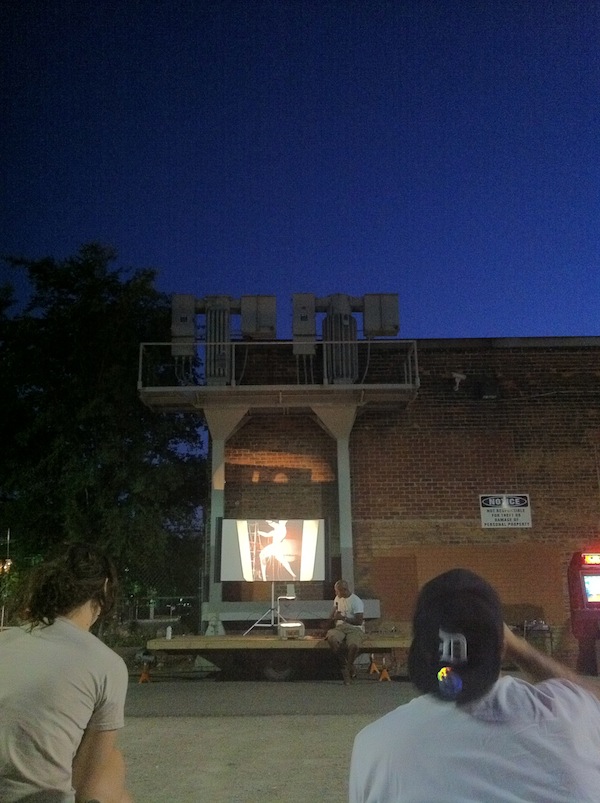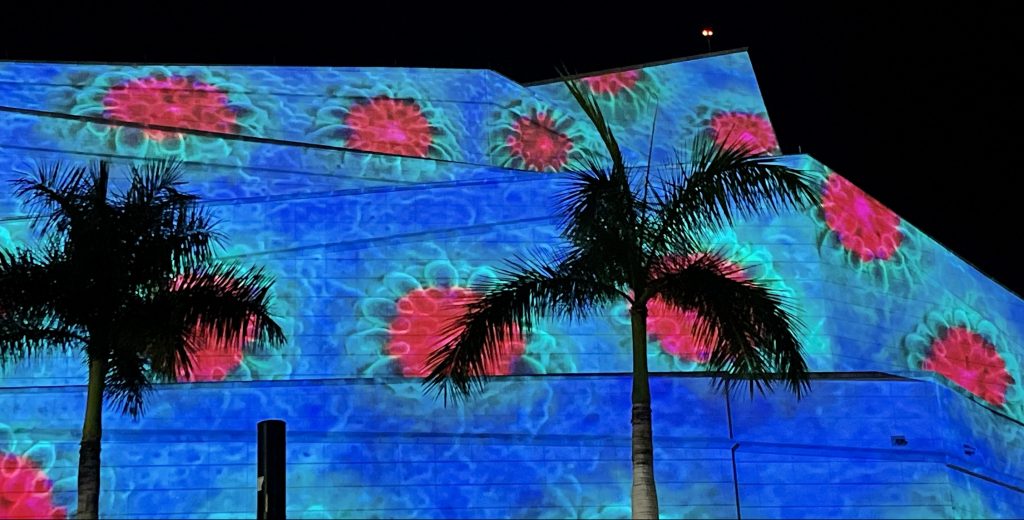
Drive-in Radio Theater returns to MOCAD
Last Wednesday, the Museum of Contemporary Art Detroit (a Knight Arts grantee) hosted the second installment of Drive-in Radio Theater, a performance in MOCAD’s parking lot that involves piping a live broadcast hyper locally into the assembled cars. The previous installment showcased the theater group, The Hinterlands Ensemble, as well as a variety of music and dance performers. The second Drive-in Radio Theater ensemble was curated to coincide with the show currently on display in the museum — called “Post-industrial Complex,” it highlights the creations and innovations of those who have taken the matters of producing the things we need to survive and thrive quite literally into their own hands. Performers for Drive-in Radio Theater this time around were different artists and collectives discussing the projects they’ve embarked on throughout Detroit, including renovating abandoned houses, starting art galleries, producing public art and even raising pigs.
The artist Keith Parker discusses a piece of public art, as well as the gallery he started in Detroit.
I had the pleasure of speaking with Jon Brumit, the Curator of Public Engagement at MOCAD, to ask him a few questions about the show. The result of our conversation is below:
Jeremy Schmall: Where did the idea for Drive-in Radio Theater originate? Jon Brumit: In terms of art and music, music was first for me. I think the event just came out of all my experiences and influences with sound, performance, and, of course, exploring the more communal aspects of the automobile and radio, too. So having a history with radio (I’ve been working at Neighborhood Public Radio since 2004, with Lee Montgomery and Michael Trigilio) and sound (I have been informally studying and making music since I was 8) and, anyway, having a history with producing radio in public spaces, I tend to always want to expose people to the medium of radio and try to create open platforms for creation and hopefully surprises. Live performance with audio broadcast to people’s cars just seemed like a great combination. Most people do tend to think I mean a drive-in movie so I try to clarify that it’s all based on live performance in the parking lot. JS: Is Radio Theater going to be a regular feature at MOCAD? JB: That’s the hope. Radio transmission is an incredibly flexible medium, opening up well beyond the more traditional disembodied voice, so I think –even if only for the fact that each iteration of the series produces at least 8 people more experienced with radio broadcast than before – then it’s worth continuing. But the other magical thing that has now happened, so far anyway, is the sensation of the event being barely there, almost invisible but electric and highly communal. I think the absolute stripping down of the constraints and presuppositions of performance, museum programming and community engagement within the series might look like a makeshift stage and a microphone stand for the fm transmitter antenna, but what it means is that event ends up feeling incredibly free, loose and fun. I do struggle with how loose it is or should be, but I think this is one of the aspects that is proving very interesting. At the end of the day it’s an event wherein people work with – or despite – technology, communication and the byproducts of so many notions of progress … so that narrative is compelling enough for me to continue exploring for as long as possible. JS: I liked how this iteration of Radio Theater dovetails with the show currently on display, “Post-industrial Complex,” as both are very interested in taking a hands-on approach to our neighborhoods, our livelihoods and the way we live. How conscious was this decision? JB: Very conscious. Katie McGowan and I co-curated Post-Industrial Complex and we’re very proud of it, especially in terms of it helping jump start and clarify our commitment to education, public engagement and broadening the scope of artists represented within and by MOCAD. And since the Post-Industrial Complex show is so much about exploring and celebrating an expansive and unstructured creative force within our neighborhoods and other communities, it seemed logical to try to curate this season’s drive-in myself with respect to the show inside. JS: It seemed like you have a very close connection with many of these artists who presented. How did you meet them? Have you collaborated with them before? JB: Interesting point … I was curious to see how it would turn out, given that I knew most of them pretty well. I’ve actually never collaborated formally with any of them, and I actually make a concerted effort not to work (as a MOCAD curator) with so many people I know — especially all at once (given the ease of turning it into a roast!) — but in this case I thought it would be a way to point to my experiences, while working on Post-Industrial Complex, of looking for and getting to know quite a few strangers, following leads, making studio visits and the joy and inspiration that can provide: the narratives of discovery, creation and sharing all occupying public space in such close proximity in this town. So most of the people presenting and performing at this last drive-in I also met through chance or as neighbors or through friends, building something together with each of them slowly as we have all pursued our own work. Of course, there are the occasional calls for helpers we all seem to rely on which might be called “collaborating,” but this to me is more an expression of care and enjoyment through making — like helping someone make something is a version of meeting one of your friends’ parents or something, you know, illuminating in some stranger-than-fiction kind of way. JS: There seems to be a lot of interest and motivation right now for artists to come to Detroit, get homes on the cheap, fix them up and create their own creative utopias, which is super cool. Is this the future of Detroit? Or, how do you see this fitting in with the future of Detroit? JB: Great question! Low cost of living really does provide a platform for incredible discoveries, so I know — even if it’s impossible to organize – that we’re all – the entire spectrum from newly-arrived to native and remaining Detroiters – building something incredible. And with respect to the utopias or dystopias, we all live within in this town, the Detroit I met and was fascinated and inspired by was a spacious city inhabited by unhinged creative spirits, and that to me was the real-world “smooth space” that I later read and learned about in a very academic and less-real manner through Deleuze & Guitarri’s “A Thousand Plateaus.” And for the die-hard pessimists, I’m not saying everything’s great, I’m saying it’s awesome…and difficult…and very real if nothing else, which is more than many other cities or towns can truly offer regardless of any cost of living. JS: What’s in store for Drive-in Radio Theater down the road? JB: I love inviting other artists and curators to organize the event, so expect the unexpected! This season’s curator is a late minute addition not in our program guide so please watch for the announcements and come join us in the parking lot! Oh and food trucks…someone mentioned food trucks! Yes!
Recent Content
-
Artsarticle ·
-
Artsarticle ·
-
Artsarticle ·
